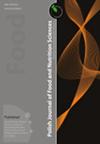Effect of Drying and Broccoli Leaves Incorporation on the Nutritional Quality of Durum Wheat Pasta
IF 2.3
4区 农林科学
Q3 FOOD SCIENCE & TECHNOLOGY
引用次数: 6
Abstract
Pasta is a great vehicle for the incorporation of vegetable-derived ingredients to increase the consumption of the health-beneficial components originating from vegetables. Notably, by-products of vegetable processing can also serve as a rich source of phytochemicals. An important step in pasta processing is drying which can affect the content of bioactive compounds in pasta. This study aimed to evaluate the effect of drying on the nutritional quality and cooking properties of durum wheat pasta fortified with broccoli leaves. Pasta enriched with broccoli leaf powder (BLP) at 2.5% (B2.5) and 5% (B5), and control pasta without BLP (C), which differed in drying conditions: fresh pasta without drying (F), pasta dried at 50°C for 8 h (L), and pasta dried at 80°C for 3 h (H) were formulated. The obtained pasta products were analysed for the cooking properties (optimal cooking time, cooking loss, water absorption and swelling capacity); colour parameters; proximate composition; and contents of free amino acids (FAA), fatty acids and sugars. BLP significantly improved the contents of ash by up to 35 g/100 g, FAA and fatty acids to up to 1298 nmol/g dry matter (DM) and 16741 µg/g DM, respectively, without compromising the cooking quality of pasta. Drying had a significant effect on fatty acids, which content in pasta processed at the highest temperature tested decreased. From the nutritional point of view, the low-temperature drying seems to be an interest ing method for pasta preparation, with the highest content of FAA, fatty acids, especially unsaturated ones, and the lowest content of sugar. However, at the same time, the dried pasta products were characterised by greater cooking loss approximating 10%.干燥和西兰花叶掺入对硬麦面食营养品质的影响
意大利面是一个伟大的载体,结合蔬菜来源的成分,以增加来自蔬菜的有益健康的成分的消耗。值得注意的是,蔬菜加工的副产品也可以作为植物化学物质的丰富来源。面食加工的一个重要步骤是干燥,干燥会影响面食中生物活性化合物的含量。本试验旨在研究干燥对西兰花叶强化硬粒小麦面食营养品质和烹饪性能的影响。分别添加2.5% (B2.5)和5% (B5)的花椰菜叶粉(BLP)和不添加BLP的对照面食(C),制备了不同干燥条件下的新鲜面食(F)、50°C干燥8 h (L)和80°C干燥3 h (h)的面食。对制备的面食进行了蒸煮性能分析(最佳蒸煮时间、蒸煮损失、吸水率和膨胀率);颜色参数;近似构成;游离氨基酸(FAA)、脂肪酸和糖的含量。在不影响面食烹饪品质的前提下,BLP显著提高了面食的灰分含量(35 g/100 g)、FAA含量(1298 nmol/g DM)和脂肪酸含量(16741µg/g DM)。干燥对脂肪酸有显著影响,在最高温度下加工的面食中脂肪酸含量降低。从营养的角度来看,低温干燥似乎是一种有趣的面食制备方法,其FAA含量最高,脂肪酸,特别是不饱和脂肪酸含量最高,糖含量最低。然而,与此同时,干面食产品的特点是更大的烹饪损失约为10%。
本文章由计算机程序翻译,如有差异,请以英文原文为准。
求助全文
约1分钟内获得全文
求助全文
来源期刊

Polish Journal of Food and Nutrition Sciences
FOOD SCIENCE & TECHNOLOGY-
CiteScore
4.30
自引率
12.50%
发文量
25
审稿时长
20 weeks
期刊介绍:
The Polish Journal of Food and Nutrition Sciences publishes original, basic and applied papers, reviews and short communications on fundamental and applied food research in the following Sections:
-Food Technology:
Innovative technology of food development including biotechnological and microbiological aspects
Effects of processing on food composition and nutritional value
-Food Chemistry:
Bioactive constituents of foods
Chemistry relating to major and minor components of food
Analytical methods
-Food Quality and Functionality:
Sensory methodologies
Functional properties of food
Food physics
Quality, storage and safety of food
-Nutritional Research Section:
Nutritional studies relating to major and minor components of food (excluding works related to questionnaire
surveys)
-“News” section:
Announcements of congresses
Miscellanea
 求助内容:
求助内容: 应助结果提醒方式:
应助结果提醒方式:


